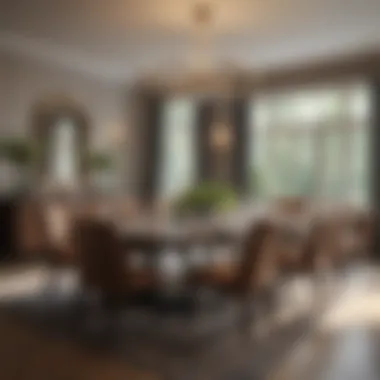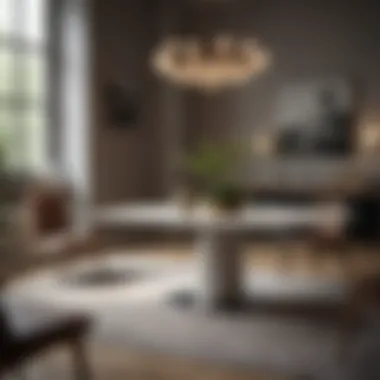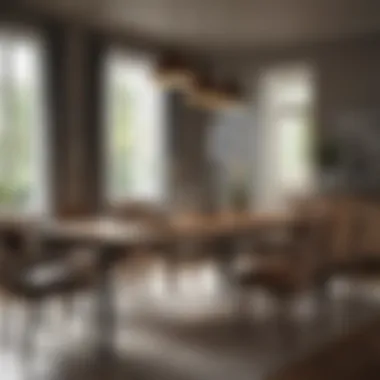Finding the Perfect Size for Your Dining Room Table


Intro
Choosing the right dining room table size involves understanding various factors that affect both functionality and aesthetics. A well-chosen table becomes the focal point of the dining space, facilitating uncomfortable social gatherings and enhancing everyday meals. This article will break down the essential components to consider when selecting the dining room table size that best fits your environment.
Design Inspirations
When considering the size of a dining room table, it is crucial to also reflect on design inspirations. The table is often the centerpiece of the room and can define the overall atmosphere.
Trending Styles
Dining tables come in various styles to suit different tastes. Whether you prefer a modern aesthetic with clean lines or a traditional look with ornate features, the style can influence the optimal size of the table you choose. Current trends lean toward larger, communal tables that encourage togetherness.
Color Palettes
The color of the dining table also plays a significant role in the overall design scheme. Light wood tones can create an airy feel, while darker woods provide warmth and sophistication. Consider how the color will fit with the existing decor to maximize the dining space's visual appeal.
Key Considerations for Optimal Size
Choosing the right size for your dining table is about more than just measurements.
Room Dimensions
Begin by assessing the dimensions of your dining area. A table should fit comfortably within the space, allowing for easy movement around it. To determine the ideal size, measure both the area where the table will sit and the space needed for chairs.
Seating Requirements
Next, consider how many people you typically host. It is a guideline that each person requires approximately 24 inches of table width. For example, a 60-inch table comfortably seats six people.
Style Preferences
Finally, the style preference should guide your decision. A long, narrow table suits a contemporary dining area, while a round table can work better in smaller or more intimate spaces.
Maintenance and Upkeep
Once you have selected an appropriate table size, maintaining it is also crucial to longevity.
Seasonal Maintenance Checklist
Regular maintenance enhances the lifespan of your dining table. Consider checking for scratches or loose joints every season and treat accordingly.
Cleaning and Organization Tips
To keep the table looking new, use gentle cleaning solutions. Avoid harsh chemicals that can damage the surface. A weekly wipe-down with a soft cloth can keep it free of dust and debris.
The combination of thoughtful design, smart size considerations, and proper maintenance leads to a beautiful and functional dining experience. Whether you host dinner parties or enjoy quiet family meals, the right table makes all the difference.
Understanding Table Size Importance
Choosing the right size for a dining room table is crucial for several reasons. It affects not only the functionality of the space but also the overall aesthetics. Selecting an unsuitable table size can lead to a cramped atmosphere or, conversely, a look that feels disconnected. The objective is to strike a balance that allows for effective use of the dining area without sacrificing style or comfort.
The dimensions of your dining room play a significant role in determining table size. A well-chosen table maximizes seating while providing enough space for the movement of chairs and guests. It should fit harmoniously within the room, complementing existing furniture and décor. Here, considerations go beyond mere measurement; they involve understanding the flow of the room and how it functions during social gatherings or quiet dinners.
Another aspect worth noting is the dining experience. The size and shape of your table contribute to how people interact during meals. An appropriately sized table promotes conversation and connection among guests. Conversely, a table that is too large may create distance, while one that is too small can lead to discomfort. A strategic selection enhances both the experience and the functionality of dining.
"Table size impacts every meal you host, shaping interactions with family and friends."
Ultimately, understanding the importance of table size is the first step in creating a dining environment that not only meets your needs but also resonates with your personal style. By considering both functionality and aesthetics, you can select a table that serves as a centerpiece of your space, inviting guests to gather and enjoy each meal.
Measuring Your Dining Space
Measuring your dining space is critical to selecting the right dining table. A table that fits the room will ensure comfort and optimal functionality. Accurate measurements help in visualizing how the table will occupy the area and allow for practical design choices. Inadequate measurements can lead to the selection of a table that either overwhelms the space or remains unsuitable for your needs.


Importance of Accurate Measurements
Accurate measurements form the backbone of effective table selection. It is not simply about fitting the table in the space but also about ensuring it serves its purpose while creating an inviting atmosphere. When measuring, consider both the dimensions of the room and how those can influence table size.
Improper measurements can lead to numerous issues, including:
- Excessively crowded dining areas, reducing accessibility
- Inadequate space for diners to comfortably pull out chairs
- Aesthetic dissonance where the table looks overwhelming or too diminutive
The goal should be to create a harmonious environment that enhances the dining experience for everyone involved.
Measuring Length and Width
To begin measuring your dining space, start with the length and width of the room. Using a tape measure, capture these essential dimensions accurately. Make note of any irregularities in the walls or any architectural features that may affect table placement.
When deciding on the dining table size, keep in mind:
- Room Length: Ideally, you want a few feet of space around the table for movement. This also includes the area behind the chairs.
- Room Width: This is equally important for ensuring a comfortable atmosphere. A narrower area might require a smaller table or a different shape, such as a round table, to maintain flow.
Accounting for Clearance Space
Proper clearance is often overlooked, yet it is essential. A table does not exist in isolation; space around it must accommodate not just the chairs but movement as well. Make sure to allow for:
- Chair Movement: Typically, 24 to 30 inches of clearance between the table and the wall or furniture allows guests to pull out chairs comfortably.
- Walkway Space: Aim for at least 36 inches for pathways around the table, facilitating easy access for serving food and moving around.
"A well-measured dining area enhances both functionality and style, marrying good design with practicality."
In summary, measuring your dining space is foundational to choosing an appropriate table. Through precise dimensions and careful consideration of clearance, you can ensure that the dining area is both welcoming and efficient.
Standard Dining Table Dimensions
Understanding standard dining table dimensions is vital when selecting the right table for your space. This component integrates function and form. A well-sized dining table ensures comfort and better interaction among guests. In this section, we will delve into the dimensions of various table shapes and their implications.
Rectangular Tables
Common Sizes
Rectangular tables are among the most popular choices for dining rooms. The common sizes usually vary from 60 to 96 inches in length. This range allows flexibility in fitting several room layouts. The choice of size can significantly enhance the room's functionality. A key characteristic of rectangular tables is their suitability for larger groups. They easily accommodate more people compared to smaller shapes.
A unique feature of common sizes is their adaptability to different room configurations. For instance, a 72-inch table can seat six to eight people, promoting a balanced atmosphere during meals. However, it could also overwhelm a small room if space is limited. This highlights the importance of considering both dimensions and room proportions when selecting the table size.
Seating Capacities
Seating capacities are essential for making dining experiences more enjoyable and stress-free. Understanding how many people can be comfortably seated at a table can help in planning gatherings. A standard rule is that each person requires about 24-30 inches of space. This guideline makes choosing the right rectangular table easier.
Additionally, the seating capacity of rectangular tables is beneficial for those who frequently host larger dinner parties. A common size of 72 inches can accommodate six people, while an 84-inch table can seat up to eight, providing ample room to eat and converse. However, overly large tables in tight spaces can lead to discomfort. Thus, balancing size and capacity is necessary for optimal dining enjoyment.
Round Tables
Typical Diameters
Round tables convey an intimate dining atmosphere. Common diameters for round tables range from 36 to 72 inches. This makes them versatile and well-suited for smaller spaces, promoting conversation among guests. A key feature is their design, which allows easy movement around the table.
For example, a 48-inch round table works well for four people, while a 60-inch table fits six comfortably. It's important to note that round tables can sometimes limit seating during larger gatherings, requiring consideration of your usual guest list size.
Benefits of Round Tables
Round tables can enhance social interaction during meals. Their shape encourages eye contact and conversation, which are pivotal in dining experiences. They are a beneficial choice for smaller dining areas where space is treasured. Their lack of corners can make them easier to navigate, making the dining environment more welcoming.
However, one downside is that round tables may not offer as much surface area for dining as rectangular tables. Therefore, if entertaining larger groups is common, it is crucial to evaluate the practicality versus aesthetic benefits of choosing round designs.
Square Tables
Advantages of Square Tables


Square tables hold a unique appeal for modern dining areas. They balance aesthetics and practicality. One significant advantage is their symmetrical shape, making them excellent for smaller gatherings. Square tables generally foster a sense of equality, as everyone is equidistant from each other.
However, a potential disadvantage lies in their seating capacity. A traditional 48-inch square table can only seat four people comfortably. For larger families or social occasions, this might impose constraints on space and interaction.
Recommended Sizes
The recommended sizes for square tables often range from 36 to 54 inches. Selecting the right size is crucial for ensuring that your dining table fits your room without overwhelming it. A 42-inch square table typically serves four, making it apt for smaller dining areas.
Choosing the appropriate size will enhance the dining experience while maintaining ease of movement and interaction among guests.
Oval Tables
Design and Functionality
Oval tables combine the features of rectangular and round tables. Their elongated shape provides larger dining surfaces while maintaining rounded edges. This design offers a stylish yet practical solution for many dining spaces. Typically, oval tables range from 60 to 72 inches in length.
A unique aspect is how they provide more comfortable seating options during gatherings, easily fitting extra chairs without feeling cramped. However, the elongated shape may affect the table's ability to provide an intimate dining experience, as the distance between guests can be greater compared to round tables.
General Measurements
General measurements for oval tables vary like their dimensions can be approximated similarly to rectangular tables. Standard sizes often lie between 60 to 72 inches in length, with widths around 36 to 44 inches. This ensures seating for six to eight comfortably.
The considerable length can be advantageous when hosting formal dinners or family gatherings. Yet, one must ensure that the space remains sufficient to allow smooth movement around the table. Understanding the dynamics between the shape's design and the overall space will significantly impact your final selection.
Factors That Influence Table Size Selection
Selecting the right size for a dining table is not merely about the physical dimensions; it's a process grounded in practicality and consideration. The number of guests expected, the shape of the dining room, and existing furniture all play significant roles in determining the optimal table size. Understanding these factors can help homeowners enhance both functionality and aesthetics in their dining spaces. It is important to assess each element carefully.
Number of Guests
The anticipated number of guests is a primary factor in table size selection. One must consider how often large gatherings occur. A dining table should comfortably accommodate regular family meals and be adaptable for hosting relatives or friends. For instance, if hosting dinner parties frequently, a larger table with extra seating might be essential. This ensures that everyone can dine together without feeling cramped.
For everyday use, a table that seats four to six may suffice; however, for occasional gatherings, consider tables that extend. Tables with features like leaf extensions can be beneficial, allowing one to adjust the table size as needed. \n
Dining Room Shape
The shape of your dining room significantly impacts table selection. Rectangular rooms typically pair well with rectangular tables. Such tables make the most of narrow spaces, allowing for smoother traffic and better flow. Round tables, conversely, are suitable for smaller or square rooms since they facilitate easier movement around the perimeter and can make the space feel more open. This leads to better interaction among diners.
Moreover, when evaluating your dining room's shape, consider the architectural features, such as windows or doors. A table positioned near these elements can optimize the dining experience by providing natural lighting and views.
Existing Furniture
The existing furniture in your dining area is another critical aspect to contemplate. A table should harmonize with the pre-existing aesthetic and functionality of your space. Consider other elements like chairs, sideboards, and cabinetry. If your chairs are large and boisterous, a smaller table may feel disproportionate. Conversely, if minimalist furniture occupies your space, a more substantial table may stand out.
It's also wise to ensure that clearance space allows for easy movement around the table. Allow at least 36 inches between the table and walls or other furniture. This helps avoid any congestion during mealtime or when hosting.
"The right table size is a balance of comfort, style, and usability, tailored to the specifics of your dining area."
In sum, recognizing the interplay of these factors will guide you toward the dining table that best suits your needs. Choosing wisely will help create a welcoming ambiance and facilitate enjoyable dining experiences.
Consideration of Table Extensions
When selecting a dining room table, consideration of table extensions emerges as a significant factor. This decision impacts both functionality and aesthetics, allowing flexibility in accommodating various numbers of guests. An expandable table can transform a compact dining area into a spacious hosting environment during gatherings while maintaining a streamlined appearance at all other times.
Expandable Tables
Expandable tables offer several advantages for homeowners. Firstly, they provide adaptability. For instance, a table that can extend gives you the option to increase seating capacity during special occasions, such as family gatherings or holiday meals. Whether you prefer a simple drop-leaf design or a more complex table with pull-out leaves, these solutions cater to diverse dining needs.
- Versatility: Adapt to different dining scenarios with ease, from casual meals to formal dinners.
- Space Efficiency: Easy to store when not in use, making them suitable for smaller areas.
- Aesthetic Choices: Many styles are available, ensuring compatibility with your existing decor.
It is important to consider how an expandable table influences your daily dining experience. While they are practical, ensure that the table maintains stability when extended. Additionally, evaluate the ease of operation; a complicated mechanism could lead to inconvenience.
Fixed vs. Extendable


The decision between a fixed table and an extendable one raises questions of lifestyle and personal preference. Fixed tables, while offering a consistent and solid structure, lack the adaptability of their extendable counterparts. However, they can be more aesthetically pleasing and emotionally reassuring due to their permanence in the dining space.
In contrast, extendable tables promise versatility, but they may require more maintenance. Here’s a breakdown:
- Fixed Tables:
- Extendable Tables:
- Pros:
- Cons:
- Always available in full size.
- Less maintenance and complex mechanisms.
- Greater design and style options.
- Limited flexibility for larger gatherings.
- May not fit comfortably in smaller spaces.
- Pros:
- Cons:
- Can adjust as per the number of guests.
- Space-saving when not extended.
- Ideal for dynamic lifestyles.
- Mechanisms may wear over time.
- Aesthetic appeal may vary by design.
Ultimately, consider your lifestyle, preferences, and the specific dynamics of your dining area when choosing between these options. An extension mechanism should not only fit your style but also nourish your dining experiences.
Styles and Material Considerations
Choosing the right style and material for your dining room table is crucial in ensuring that it fits well both with your space and lifestyle. The dining table serves as a focal point in many homes, where gatherings and meals take place. It is essential that this piece complements the overall decor of the room and is made of materials that meet your preferences for maintenance and durability.
Matching with Decor
When selecting a dining table, consider how its style integrates with the rest of your decor. The table should harmonize with existing furniture, lighting, and wall colors. There are various styles to choose from, each with unique aesthetics. For instance:
- Modern Tables: Characterized by clean lines and minimalistic design, often made from materials like glass or metal.
- Traditional Tables: Usually crafted from solid wood, featuring intricate carvings that reflect craftsmanship.
- Rustic Tables: Often reclaimed wood is used, giving a natural, earthy feel that brings warmth to your dining space.
It helps to visualize how various table styles will interplay with your room's existing elements. Using samples or even digital design tools can greatly assist in this process. Ensure that the table complements the scale of your room, avoiding overwhelming smaller spaces while filling larger areas effectively.
Durability and Maintenance
Durability is another factor that must be taken into account when selecting a material for your dining table. Common materials include wood, glass, and metal, each offering different advantages:
- Wood: Offers strength and warmth but requires regular maintenance to prevent scratches and stains. Hardwoods like oak and walnut are popular due to their endurance and ability to age gracefully.
- Glass: Provides a contemporary look, creating an illusion of space. However, it can be prone to scratches and fingerprints which necessitate more frequent cleaning.
- Metal: Known for its strength, often used in industrial-style tables. It can last long but may need protective coatings to avoid rust or corrosion.
Proper maintenance for all materials is necessary to keep the table looking its best. This may include regular cleaning for surfaces that show wear easily.
"A well-chosen table not only contributes to the beauty of a dining area but also withstands the demands of daily use."
Selecting the right styles and materials allows the dining room table to seamlessly blend into your home while offering lasting functionality. The conscious decision can elevate your dining experience, providing a space where both aesthetics and durability coexist.
Final Decision-Making Process
The final decision-making process is crucial when selecting the optimal size for your dining room table. This phase integrates all prior considerations into a practical choice that enhances both usability and aesthetics. It is not merely about picking a table; it is about ensuring that the table functions well in your space while also aligning with your design preferences.
Compiling Your Data
At this stage, gathering all your measurements and notes is essential. Compile the space dimensions, desired seating capacities, and style preferences. Creating a checklist can be beneficial. This checklist can include:
- Room length and width
- Desired clearance space around the table
- Number of guests you typically host
- Preferred table shape and materials
Review this compiled data to determine patterns or conflicts. For instance, if your measurements suggest one style while your guest count favors another, this will help clarify what is most important to you.
Visualizing the Space
Visualization plays an important role in this process. It allows you to picture how the table will fit into your dining area. A practical approach is to use masking tape or chalk to outline the dimensions of the table on the floor. This method helps you see the table’s footprint in your space. It enables you to experience the flow of movement around the table. Ensure that you have enough space for chairs, access, and natural movement within the room.
Another option is to use online room design tools or apps. These applications allow you to create a virtual representation of your room, adjusting different elements without physical effort.
Trial with Furniture Models
If possible, visit a showroom. Testing out various table models and sizes can provide insights you might not discover from online research alone. Sitting at tables of different sizes and shapes can help you understand comfort levels and spatial dynamics.
Additionally, if you can borrow or rent a similar table temporarily, do so. This practical experience reinforces your measurements and visualization efforts. Observing how the table fits into your daily life can reveal any potential issues. For example, do you have enough room to move around it when it is fully set for a meal? Is the height appropriate for your dining chairs?
The more informed you are during this process, the more satisfying your final decision will be.







